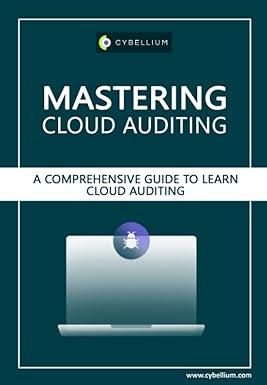Question
Why are investments in marketable securities shown separately from cash equivalents in the balance sheet? 2. Explain the fair value adjustment procedure for short-term investments
Why are investments in marketable securities shown separately from cash equivalents in the balance sheet?
2. Explain the fair value adjustment procedure for short-term investments classified as available for-sale securities
3. What does the account Unrealized Holding Gain (or Loss) on Investment represent? How is this account presented in the financial statements for short-term investments classified as available-for-sale securities?
4. The Cash account in the general ledger of Hendry Corporation shows a balance of $96,990 at December 31, 2015 (prior to performing a bank reconciliation). The companys bank statement shows a balance of $100,560 at the same date. An examination of the bank statement reveals the following:
1. Deposits in transit amount to $24,600.
2. Bank service charges total $200.
3. Outstanding checks total $31,700.
4. A $3,600 check marked NSF from Kent Company (one of Hendry Corporations customers) was returned to Hendry Corporation by the bank. This was the only NSF check that Hendry Corporation received during 2015.
5. A canceled check (no. 244) written by Hendry Corporation in the amount of $1,250 for office equipment was incorrectly recorded in the general ledger as a debit to Office Equipment of $1,520, and a credit to Cash of $1,520.
In addition to the above information, Hendry Corporation owns the following assets at December 31, 2015:
(1) money market accounts totaling $75,000,
(2) $3,000 of high-grade, 90-day, commercial paper, and
(3) highly liquid stock investments valued at $86,000 at December 31, 2015 (these investments originally cost Hendry Corporation $116,000).
On December 1, 2015, Hendry Corporation sold an unused warehouse to Moran Industries for $100,000. Hendry accepted a six-month, $100,000, 6 percent note receivable from Moran. The note, plus accrued interest, is due in full on May 31, 2016. Hendry Corporation adjusts for accrued interest revenue monthly.
Hendry Corporation uses the income statement approach to compute its uncollectible accounts expense. The general ledger had reported Accounts Receivable of $2,150,000 at January 1, 2015. At that time, the Allowance for Doubtful Accounts had a credit balance of $40,000. Throughout 2015, the company wrote off actual accounts receivable of $140,000 and collected $21,213,600 on account from credit customers (this amount includes the $3,600 NSF check received from Kent Company). Credit sales for the year ended December 31, 2015, totaled $20,000,000. Of these credit sales, 2 percent were estimated to eventually become uncollectible.
Instructions
a. Prepare Hendry Corporations bank reconciliation dated December 31, 2015, and provide the journal entry necessary to update the companys general ledger balances.
b. Compute cash and cash equivalents to be reported in Hendry Corporations balance sheet dated December 31, 2015.
c. Prepare the adjusting entry necessary to account for the note receivable from Moran Industries at December 31, 2015.
d. Determine the net realizable value of Hendry Corporations accounts receivable at December 31, 2015.
e. Determine the total dollar amount of financial assets to be reported in Hendry Corporations balance sheet dated December 31, 2015.
f. Assume that it is normal for firms similar to Hendry Corporation to take an average of 45 days to collect an outstanding receivable. Is Hendry Corporations collection performance above or below this average?
Step by Step Solution
There are 3 Steps involved in it
Step: 1

Get Instant Access to Expert-Tailored Solutions
See step-by-step solutions with expert insights and AI powered tools for academic success
Step: 2

Step: 3

Ace Your Homework with AI
Get the answers you need in no time with our AI-driven, step-by-step assistance
Get Started


